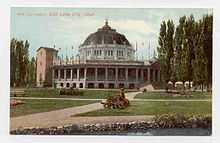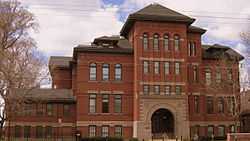Richard K.A. Kletting
Richard Karl August Kletting (July 1, 1858 – September 25, 1943),[1] most commonly known as Richard K.A. Kletting, was an architect in Utah. His design for the Utah State Capitol was chosen over 40 competing designs. A number of his buildings survive and are listed on the U.S. National Register of Historic Places including many building in University of Utah Circle and the Salt Lake City Warehouse District. Other works include the Enos Wall Mansion, now a landmark for the LDS Business College campus, and the Old Saltair Resort Pavilion.
Kletting also trained many architects that went one to be influential architects in Utah including Richard C. Watkins, Carl M. Neuhausen, and Leslie S. Hodgson.
He was born in the Kingdom of Württemberg in 1858; he died in Salt Lake City, Utah on 25 September 1943.[1]
He was interested in forestry. Kletting Peak, a 12,000-foot mountain in Summit County, Utah is named for him, recognizing his contribution to forestry.[1]
Gallery
Other Works on National Register of Historic Places
- J. R. Allen House, built 1899, 1047 E. 13200 South, Draper, UT [2]
- William F. Beer Estate, 181 B St. and 222 4th Ave., Salt Lake City, UT [2]
- Gibbs-Thomas House, 137 NW Temple St., Salt Lake City, UT [2]
- Karrick Block, 236 S. Main St., Salt Lake City, UT [2]
- Lollin Block, 238 S. Main St., Salt Lake City, UT [2]
- McIntyre Building, 68-72 S. Main St., Salt Lake City, UT [2]
- New York Hotel, 42 Post Office Pl., Salt Lake City, UT [2]
Works no longer standing
- First Salt Palace
- Saltair Pavilion
- Riverton Ward Meetinghouse
References
- ↑ 1.0 1.1 1.2 Gold, Troy W. (1994), "Kletting, Richard Karl August", in Powell, Allan Kent, Utah History Encyclopedia, Salt Lake City, Utah: University of Utah Press, ISBN 0874804256, OCLC 30473917
- ↑ 2.0 2.1 2.2 2.3 2.4 2.5 2.6 "National Register Information System". National Register of Historic Places. National Park Service. 2009-03-13.








